"LOleander (nerium oleander) hija pjanta li tappartjeni għall-familja ta' apocynaceae. In some areas of Italy (South and islands) it is now naturalized and is widely cultivated as a shrub or ornamental tree. The cultivation of oleander is very widespread due to the rusticity of the plant and obviously for its splendid and prolonged flowering. Nonetheless, it is also one of the pjanti velenużi most dangerous ever, with a long history of the toxicity risks of all its parts.
In this article we describe the botanical characteristics of the oleander, the techniques for growing it in the garden and the elements of toxicity of the plant for humans and animals.
Regional names of the oleander
To demonstrate the great diffusion of the oleander in our territory, here are a series of regional names with which this ornamental plant is known: sabiħa u leandru fil-Ligurja, leander fil-Piemonte, aleander fil-Veneto, leandar fl-Emilia, clubs of St. Joseph fit-Toskana, mange plant fl-Abruzzo, Leandro fil-Kampanja, liandro fil-Puglia, landru Fil-Kalabrija, lannaru u rannulu fi Sqallija, leonasci u neulache f’Sardinja.
Deskrizzjoni ta ' nerium oleander
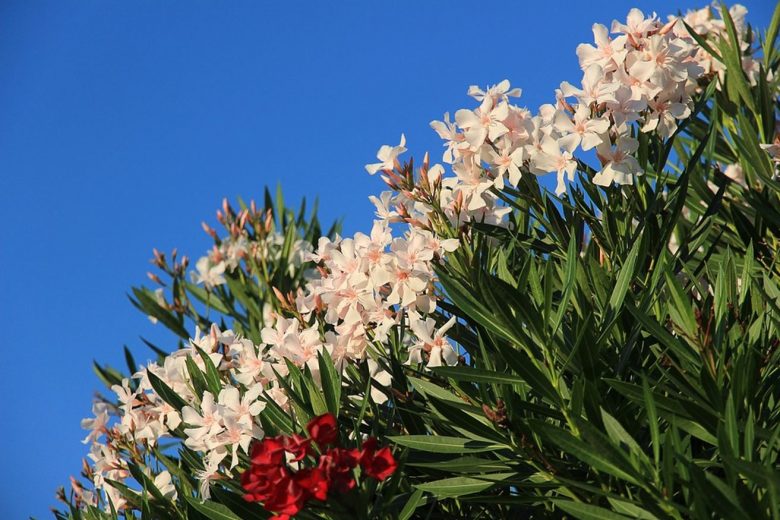
In nature, the oleander grows as a medium-sized evergreen shrub with a bushy habit. The largest specimens even exceed 5 m in height. The plant has a great polloniferous attitude and develops from the collar stems initially erect and branched, then slightly arched outwards. The young branches have smooth bark, pruinose surface, first green, then greyish color.
The oleander can also be grown as a small sapling, especially when it is planted in avenues to create trees. In this case it is laid at about 2 m in height, pruning the head of a willow and eliminating the numerous suckers it emits.
Weraq
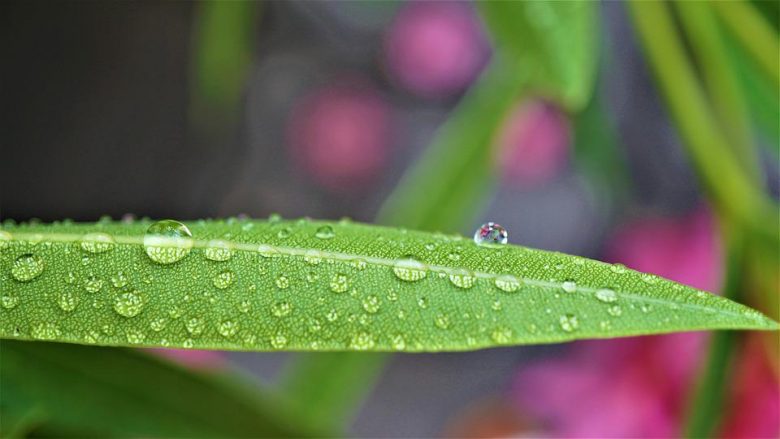
The leaves of the oleander are normally arranged opposite on the branches or, sometimes, especially in the young shoots, verticillated at 3 or 4. They have a short petiole, but robust and dilated at the base, the leaf blade is lanceolate, the apex is as acute as the base, the margin is whole, the consistency leathery.
On the lower page a robust main rib is visible from which numerous secondary ribs parallel to each other start. The color is glossy green on the upper page, lighter and tending to gray on the lower page.
fjuri
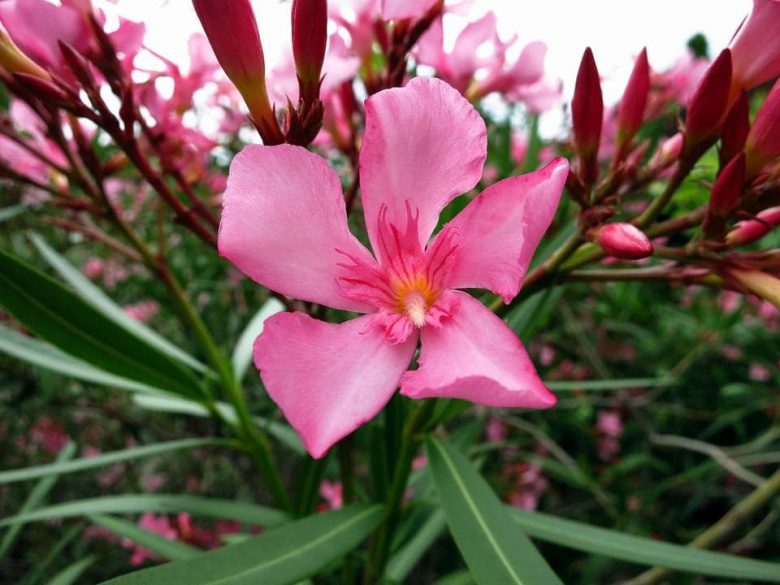
Oleander plants typically bear the flowers (large, showy and fragrant) in groups gathered in corymbs at the apex of the branches. The flowers are tubular, with a short 2-3 mm peduncle. The petals can be single or double, the color variable (pink, white, red, etc.) depending on the variety. A characteristic feature of the oleander is the very long flowering period, in fact the first flowers are seen already in April or May and the last ones at the beginning of autumn. This peculiarity explains the success of nerium oleander as an ornamental species.
Frott
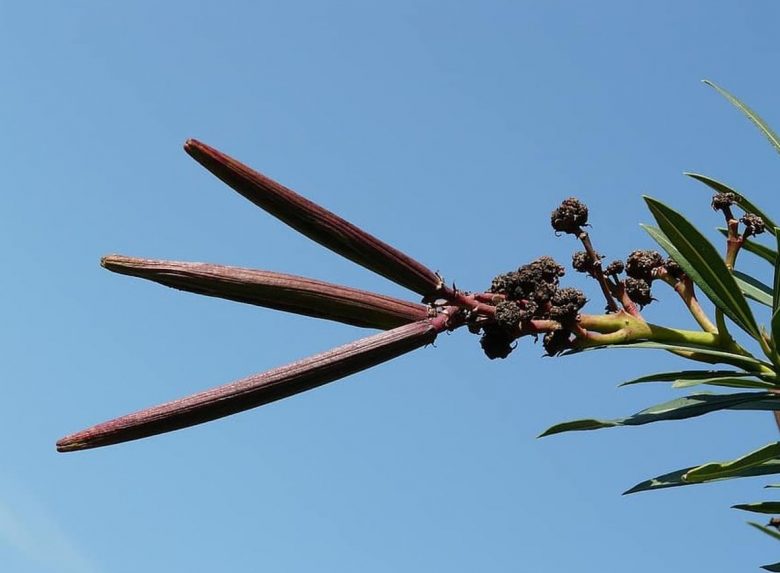
The fruit is formed by two follicles welded together and inside which the feathery seeds are contained. The dissemination, thanks to the “pappus”, takes place by the wind.
Variety of oleanders
The one just described is the type species, nerium oleander, that is what we find spontaneous in nature and in most gardens. But over time, gardeners have developed dozens of oleander varieties, which differ mainly in the shape and color of the flowers. Some of these are:
- Angiolo Pucci: simple and ivory yellow flower;
- Luteum Plenum: double flower, yellow color;
- Sour Agnes: single flower, white color;
- Mont Blanc: single flower, white color;
- Alsace: single flower, pinkish white color;
- L-Italja: single flower, light red color;
- Roseum plenum: double flower, pink color;
- Jannoch: single flower, red color;
- Provencedouble flower, salmon color;
- Soleil levant: single flower, salmon color;
- Giant des batailess: double flower, red color.
How to grow oleander
In nature, oleander grows spontaneously in sandy and stony environments, such as the shores of rivers and streams. It also grows on limestone cliffs. We find it from sea level up to 500-700 m of altitude. It does not tolerate prolonged cold, with temperatures below -5 / -7 ° C. It is in fact a typical Mediterranean species, cultivated everywhere along the coasts. To flower at its best, it needs sunny exposures, half shade is not recommended.
It expresses a great vegetative luxuriance when the soil is moist. It is able to withstand long periods of drought thanks to the modification of the foliar stomata. Where winters are very cold, with prolonged frosts, oleander cultivation does not perform at its best. The ideal terrain it is sandy or of medium texture, with a pH newtrali jew sub-alkalin. It can also be grown in pots, in this case it has limited development, but it can protect from winter frost.
Multiplikazzjoni
The oleander can be multiplied with the teknika tal-qtugħ taking 10-15 long portions of semi-woody and budded branches. The operation is carried out in spring, placing the cuttings in small jars filled with soil and perlit. The cutting is kept in pot until the following spring, when it can be planted permanently in the garden or in a pot.
When cutting the cuttings, wear latex gloves and, when finished, disinfect the scissors used with alcohol.
Tħawwil
Usually we prefer to buy oleander plants already well rooted in the nursery. The growth of the plant itself is fast and using the plants in earthen bread is even faster. The best time to plant oleander is in early spring, when the cold returns are now behind us. When transplanting, take into account the future development of the shrub which will be vigorous. We therefore advise you to leave enough space between one plant and another, at least 2 m. More dense transplants will over time form a real hedge, which is often observed in Mediterranean gardens.
Fertilizzazzjoni
Dig a hole sufficiently wide and deep and put organic fertilizer on the bottom (mature manure, compost or earthworm humus) to ensure initial fertilization. Once a year, in the fall or spring, add fertilizer by hoeing the organic matter around the collar.
For transplanting in pots, use containers at least 2 times larger than the starting one, using a good universal soil mixed with 15-20% sand. At the bottom of the pot, place some expanded clay to ensure sufficient drainage. Also for potted oleander we recommend one fertilizzazzjoni organika ta 'kull sena.
irrigazzjoni
Except for the first year of life (period in which the plant breaks free) or for potted plants, oleander irrigation is practically never necessary. If the plant is well rooted in the ground, natural rainfall will be sufficient (albeit scarce).
Pruning of the oleander
At the beginning we told you about the breeding pruning to grow the sapling oleander. The tree shape must be maintained with the periodic elimination of suckers from the stump and return cuts on the high branches.
The oleander in natural bushy shrub form is easier to maintain, with the plant that can basically be left free to grow, only removing excess suckers and thinning out in the central part to ensure air circulation.
The situation is different if you want to grow the oleander as a hedge, in this case, at the end of winter or after summer flowering, back cuts are made on the protruding branches, in order to maintain a more compact shape.
During oleander pruning protect yourself using gloves and glasses and don’t forget to disinfect pruning tools.
Parassiti
The oleander also suffers from the presence of various parasites, although it must be said that the shrub is extremely rustic and hardly perishes.
In spring, pay attention to the presence of aphids which smear the young shoots, with relative vegetative decay, e cause smokiness. At the first signs of infestation, intervene with abundant washes with soft potassium soap.
Other problematic pests for oleander are a few types of mealybugsfor example: the kuċċinilla nofs bżar (saissetia oleae)), Il fig cochineal (Ceroplastes rusci) u l- citrus cotonello (Planococcus citri) we have already told you about.
Diseases of the oleander
As for diseases, pay attention to oleander mangea bacterial disease caused by Pseudomonas savastanoiwhich is the same bacterium that causes the mange tas-siġra taż-żebbuġ. The presence of mange on nerium oleander it is noted for the growths that grow on the branches, a sort of tubercles with a spheroidal shape and a brownish color. The affected part undergoes desiccation and proliferation of diseases in the healthy branches. The best thing that can be done is to cut the branch from the bottom and remove the vegetative material. Once this is done you can intervene by disinfecting with a copper-based fungicide product or with the żeolit.
Toxicity and risks of oleander
Everyone knows that the poisonous oleander, the toxicity is due to oleandrina cardio-toxic glycoside, and other alkaloids contained in leaves, flowers, wood and seeds.
In case of involuntary ingestion, gastric disturbances (burning, vomiting), brachycardia, increased respiratory rate, disorders of the nervous system are recorded.
Externally, therefore on the skin, the risk is that of severe irritation (for this reason we have advised you to use gloves when pruning oleander).
Human ingestion is unlikely, also because the oleander does not produce berries and the leaves have a terrible taste, so the risks highlighted are very relative. Theoretically, horses, cattle and other herbivores are most at risk.
Curiosities about the oleander
In the past, oleander fronds were used as a funerary plant, also because, as Pliny recounts, it was already known that it was able to kill wild animals.
Another famous legend is the one that tells of a group of soldiers during the Napoleonic campaigns who were killed or intoxicated by the improper use of oleander branches, used as a rotisserie for meat.
More recently, the oleander infusion is used as a poison in the film Oleander abjad.

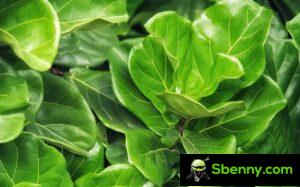
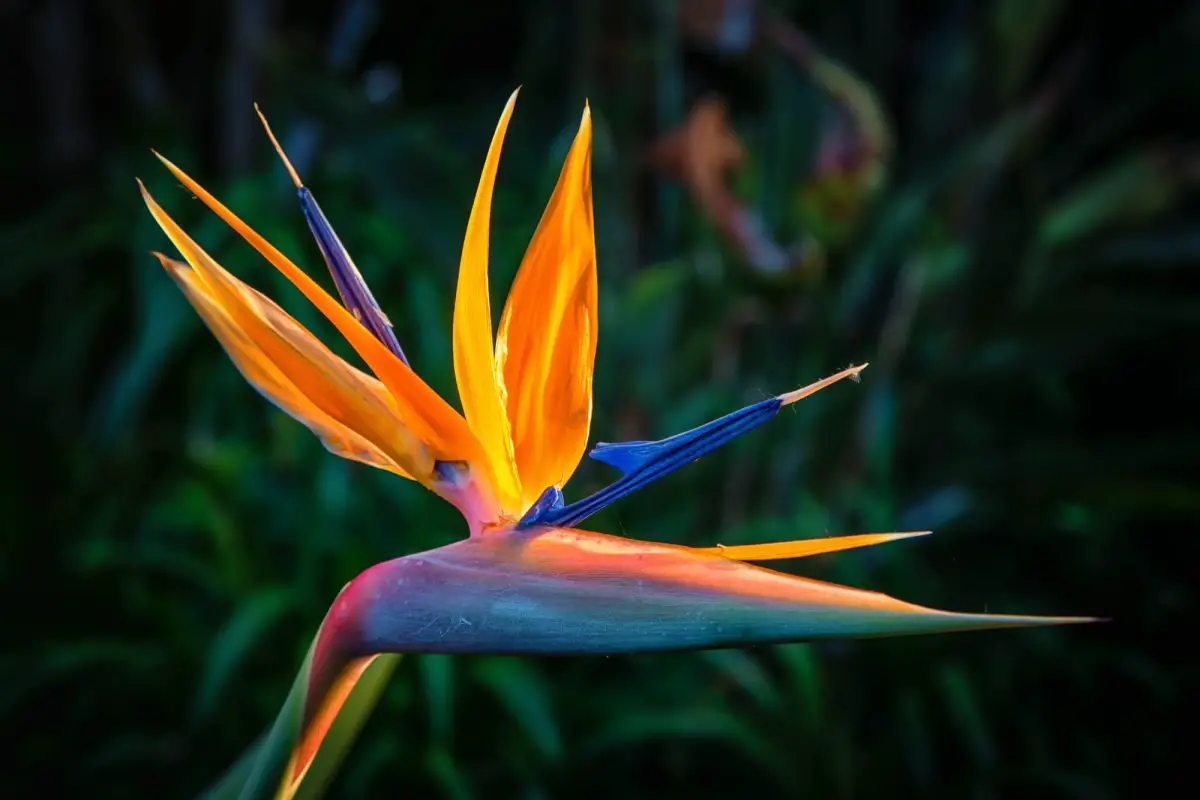
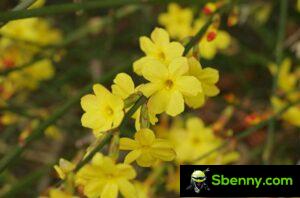
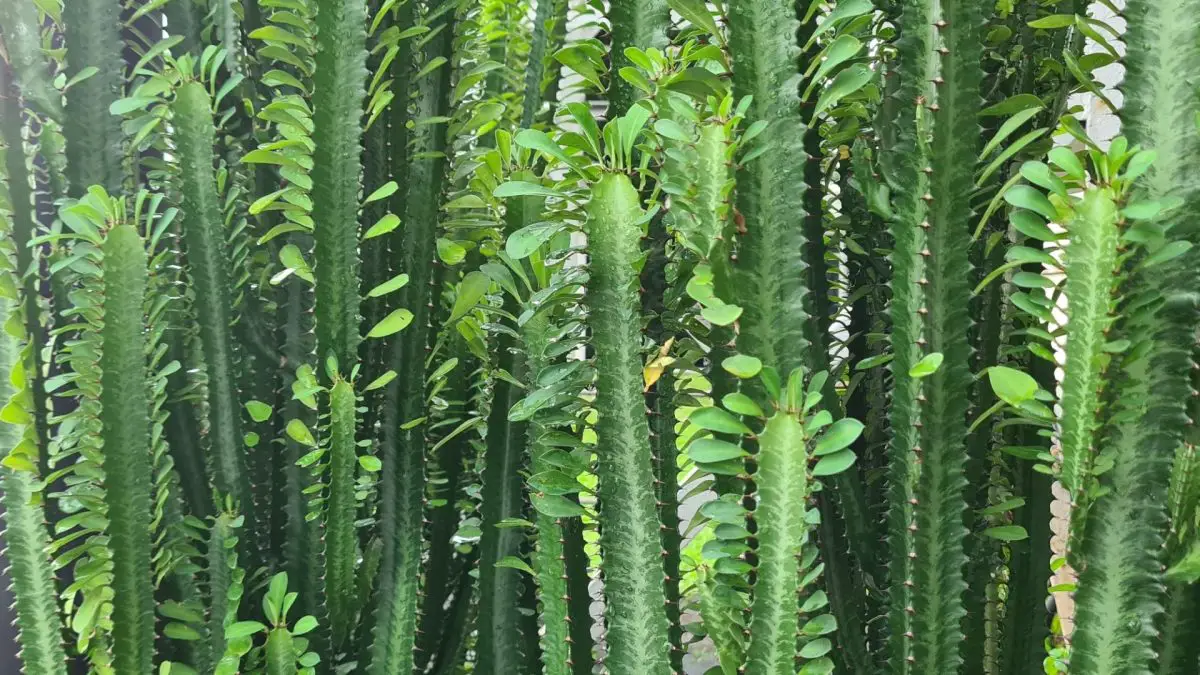
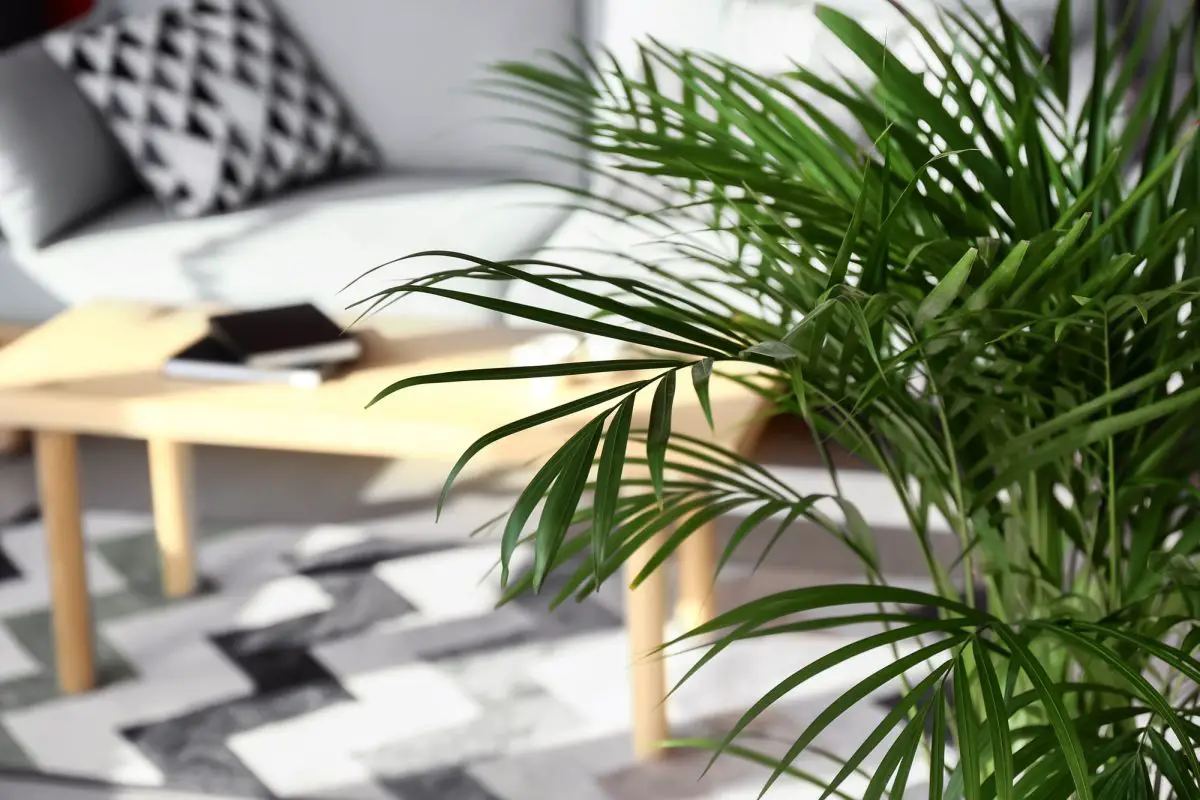
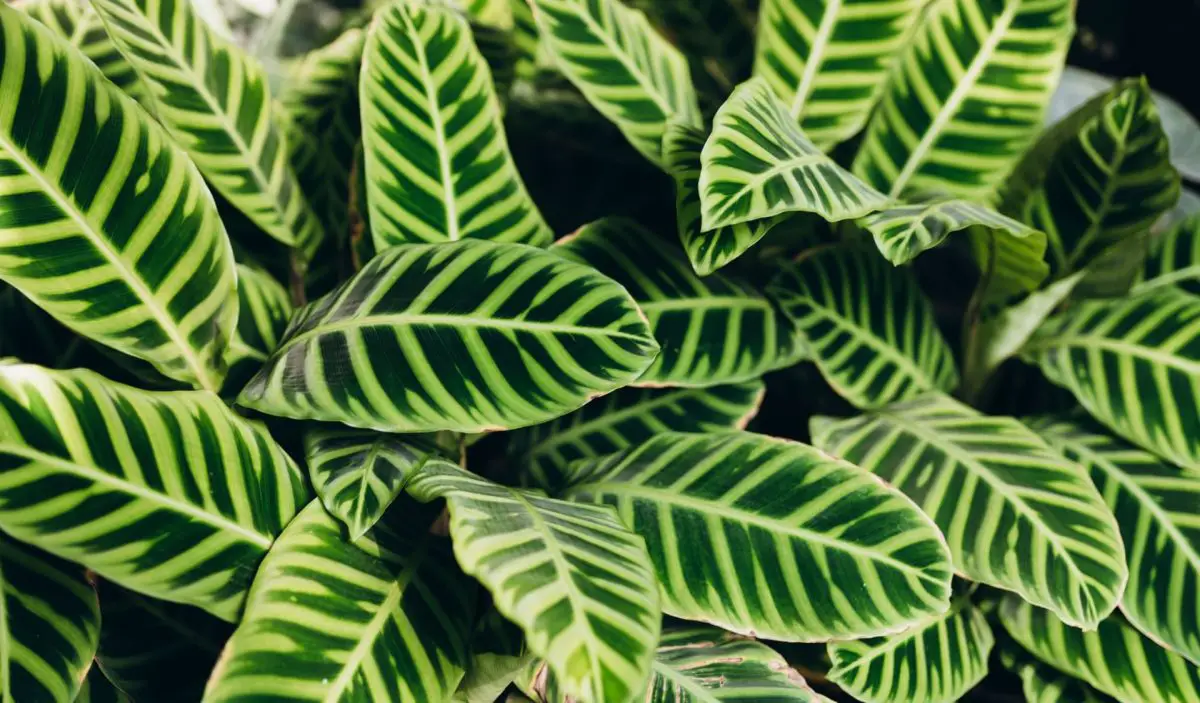
Ibda Thread ġdid